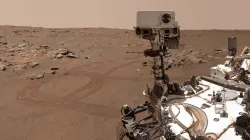Sending people to Mars? Here are some invisible problems you must know
Balancing the risks of space travel against the immense potential of space exploration is a challenging yet crucial endeavour. Despite the health dangers, the scientific discoveries that could result from sending humans to Mars hold the promise of being revolutionary.

Sending humans to Mars comes with an array of daunting challenges. There are obvious logistical hurdles like launching people and supplies into space and safely landing them on the Martian surface. Once there, astronauts will need safe habitats, breathable air, potable water, and food to survive. However, one of the most significant and often overlooked obstacles to human exploration of Mars is the invisible yet dangerous threat of space radiation, which can wreak havoc on the human body.
According to The Verge, while Elon Musk is busy envisioning future Martian cities, experts in human space exploration are taking a more cautious approach. Even if landing on Mars is possible, ensuring the safety of the astronauts might be the more difficult part.
Space radiation: An unseen enemy
Decades of research aboard the International Space Station (ISS) have shown that microgravity impacts human health, leading to muscle atrophy and vision problems. But leaving Earth also means departing its protective magnetic field. This is where space radiation poses a massive, largely unknown threat to human health.
Space radiation comes from two primary sources: solar flares and galactic cosmic rays. "Galactic cosmic rays originate from stars in their death throes and permeate the void of space," explained radiation expert Eleanor Blakely to The Verge. While the health risks associated with space radiation are numerous, they remain poorly understood. Space radiation is believed to increase cancer risk, damage the central nervous system, contribute to degenerative conditions like heart disease, and even affect the immune system.
A different kind of radiation
One of the key challenges with space exploration is the prolonged exposure to low levels of radiation. This exposure differs significantly from the type of radiation we commonly encounter on Earth, such as gamma rays and X-rays, which spread damage evenly across the body. In contrast, galactic cosmic rays behave differently, travelling through the body in straight lines and causing concentrated damage on a microscopic scale. "Because the damage is so focused, it's much harder for the body to repair," radiation biologist Greg Nelson, who advises NASA, told The Verge.
Unlike radiation from a chest X-ray, space radiation acts like a charged particle moving at nearly the speed of light, travelling through the brain and affecting thousands of cells in microseconds. Although it may not directly damage these cells, it disrupts them in ways we do not yet fully understand.
Compounding problems in space
Astronauts are exposed not only to radiation but also to the health challenges posed by microgravity. Loss of muscle mass is a well-known issue, but recent evidence suggests microgravity might also lead to brain remodelling. However, as Blakely pointed out, "What are the psychological or physiological consequences? We don't know."
Microgravity and radiation exposure might even interact with each other, but scientists are unsure whether the effects are additive or synergistic. This means that in space, health risks could stack up or worsen when combined, further complicating efforts to protect astronauts.
Heading to Mars: Navigating radiation risks
NASA’s calculations suggest that longer missions to Mars could expose astronauts to over one sievert of radiation, exceeding the agency's acceptable lifetime exposure limit. The bulk of this exposure occurs during space travel rather than on the Martian surface, where there is some natural protection. Short missions, lasting up to a month, are unlikely to cause severe effects, but missions of six months or longer raise concerns.
Travel timing can mitigate radiation exposure. The sun goes through an 11-year cycle, and travelling during solar maximum can reduce cosmic ray exposure, although it increases solar radiation risks. Nuclear propulsion, a technology NASA is exploring, could shorten travel time, but it also comes with its own set of risks.
Mitigating the Radiation Problem
Shielding astronauts from radiation is an option, but it’s complicated. “Most people think putting on lead shielding will suffice,” Nelson explained, "but that’s not effective with charged particles." These particles break into smaller fragments, which can penetrate more deeply than the original radiation.
There is a "sweet spot" for radiation shielding—enough to block larger particles but not so much that it creates harmful fragments. Polyethylene, rich in hydrogen atoms, maybe a better shielding material than metal. Still, even with the best shielding, astronauts will inevitably face some level of radiation exposure during their mission.
Weighing the risks of space exploration
NASA enforces strict radiation exposure limits for astronauts, equivalent to a 3–4 per cent excess mortality risk. Setting these limits is complicated because different types of radiation affect individuals differently, and factors like age, gender, and health further complicate the equation.
According to The Verge, astronauts themselves often accept the personal risks of space exploration. After all, the inherent dangers of spaceflight—such as spacecraft malfunctions—are already life-threatening. However, space agencies like NASA also consider the perspectives of astronauts' families, who have a vested interest in their loved ones' long-term health and safety.
Balancing the risks of space travel with the potential rewards of exploration is a delicate task. While the health risks are daunting, the scientific knowledge and potential benefits gained from human exploration of Mars could be transformative.
Ultimately, while the vision of glittering Martian cities may seem distant, small, carefully considered missions could bring us closer to unravelling the mysteries of space. However, understanding and mitigating the risks will be crucial to ensure that the rewards of exploration do not come at too great a cost.
ALSO READ: WhatsApp to add Spam Blocker for unknown accounts: How will it work?
ALSO READ: Google introduces AI-powered Search Results in India for English and Hindi users